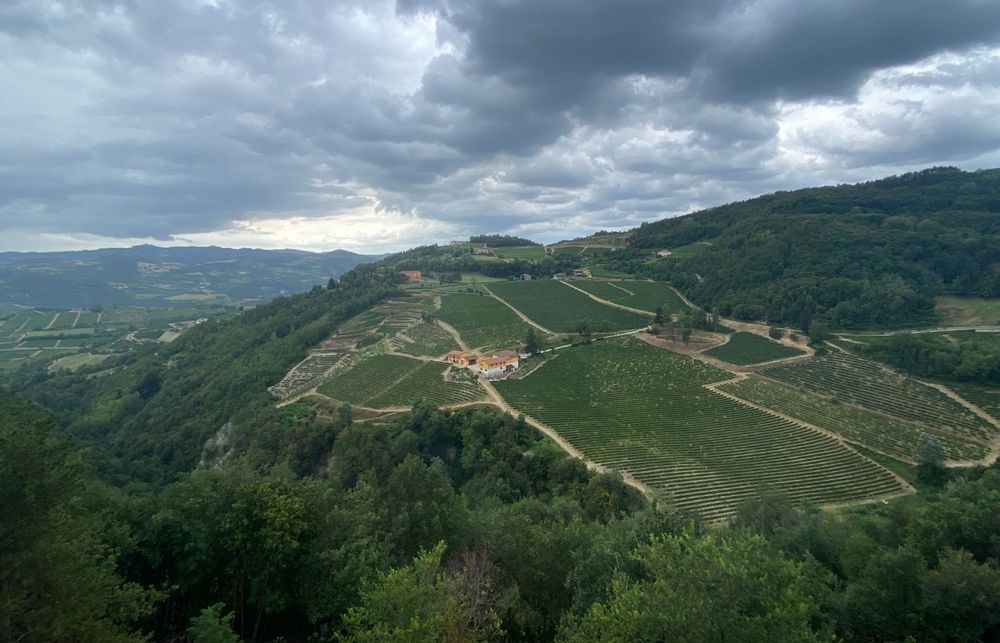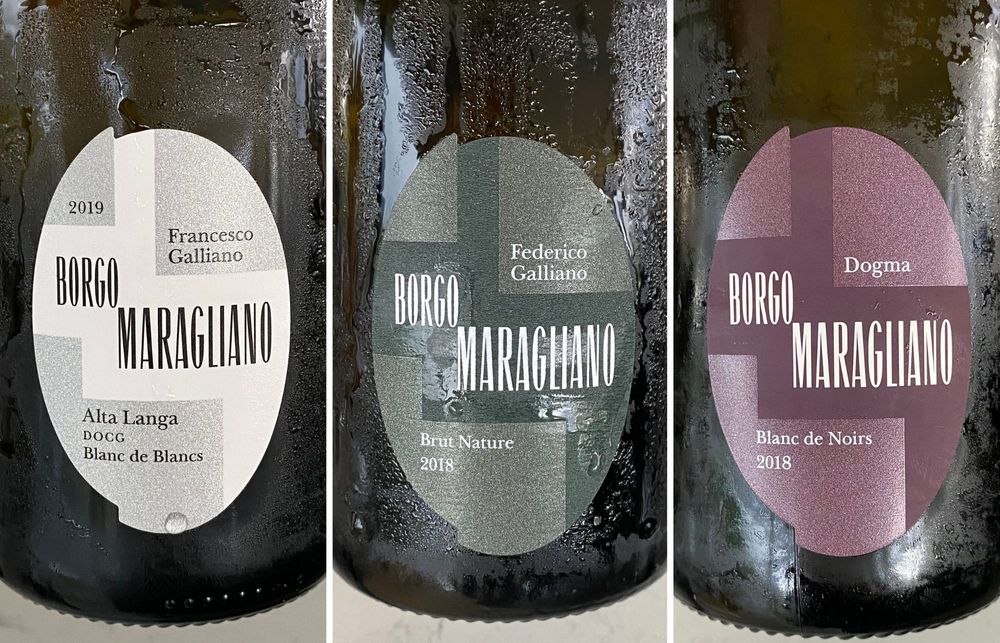“With the likes of Borgo Maragliano and Fratelli Gancia being joined by the famous names of Ettore Germano and Fontanafredda, as well as the co-operatives such as Vallebelbo and Terre del Barolo, there are styles and price points to suit most buyer’s needs. Alta Langa DOCG appears primed and ready for the top table of sparkling wines,” writes Turner.

The historic Borgo Maragliano in the commune of Loazzolo
Piemonte is a true destination for wine lovers across the globe. If you get a chance to visit the winding streets of the famous red wine villages of Barbaresco or Barolo, the multitude of nationalities of the registration plates adorning the shiny, expensive cars let you know that this is where the well-heeled vinophiles enjoy their holidays. Once there, they can have their horizons expanded to include top class Barbera and Dolcetto, even the whites of Arneis and Naschetta. But what if they want a glass of bubbles to kick off the afternoon’s aperitivo?
Even now, so little is known about the production of top class Metodo Classico in Piemonte that even wine bars in the centre of the biggest tourist destinations in the regions still stock the famous names of Champagne to cater for their punters. In what would be an anathema in any other section of the wine list, French bubbles still hold centre stage. But as quality, confidence and volumes all rise, now is the moment for Alta Langa DOCG to step out of the shadows and show the world that Piemonte produces truly world class sparkling wines.
What is Alta Langa?

The rolling hills of Piemonte planted with Pinot Nero and Chardonnay
Alta Langa DOCG is the name given to a set of traditional method sparkling wines of Piemonte. The wines can only be made from Pinot Nero or Chardonnay (as a blend or varietal), either white or rosé and only in Brut or Brut Nature styles. It’s also subject to a minimum of 30 months on the lees, with many wines in this style far exceeding that for depth and complexity.
Although the DOCG was only granted in 2011 (the DOC in 2002), traditional method sparkling wine from Piemonte has been around for nearly 150 years. The man behind the dream was Carlo Gancia. He believed that the hills of Piemonte were perfect for grapes for top quality sparkling wine, he just didn’t know how to make them. In 1848 he set out to work for Perrier-Jouet in Reims, returning two years later to set up his legendary business, and producing his first “champenoise” Italian Spumante by 1865.
Over the next century, more producers joined by planting Pinot Nero and Chardonnay on the hills around the town of Canelli, but production remained modest. It wasn’t until 1990 that a group of producers aimed to set down a set of rules and a direction for the now snappily titled “Spumante Metodo Classico in Piemonte” project. Even then the 21 estates involved managed only 20 hectares of Pinot Nero and Chardonnay, but the wheels were in motion. By 2002 the newly named Alta Langa had its own DOC, being upgraded to DOCG status just 9 years later.
The pioneering story behind Borgo Maragliano

Borgo Maragliano’s Carlo Galliano: 1982 was the turning point
The Galliano family have farmed the hills around the village of Loazzolo since purchasing their first land there in 1850, when patriarch Giovanni became involved in the first wave of metodo classico wines in the wake of Carlo Gancia’s adventures. There was a break in 1909 as the advent of phylloxera destroyed the family’s vines and it wasn’t until 1935 that they returned to the wine industry as growers of Moscato grapes, eventually leading to a long-term contract to supply Cinzano Spumante long into the 1980s.
Current owner and head winemaker, Carlo Galliano, considers 1982 the most important year in the journey of the winery. “I remember it like it was yesterday,” remembered a beaming Galliano. “The Moscato market was going crazy, with grapes selling in 1982 for five or six times the price of 1981. It was a bubble, and my father saw it. He asked me, even as a 12 year old, what I thought we should do. It was then it was decided to go back to planting Pinot Nero and Chardonnay.”
In 1983 they planted their first 3.5 hectares, with vine clones from Champagne. By 1988 it was time to bottle their first vintage. “We made 1,400 bottles in that first year,” mused Galliano. “I was at the oenological high school in Alba and 13 or 14 of my mates came to help bottling. Then we had a big lunch and a big laugh, it was a lot of fun. We did that same routine every year until the mid 90s when the production volume was a bit too large for it to be fun anymore!”
A steady rise in production volumes over the past 30 years has now seen bottling numbers reach over 150,000 by the 2022 vintage, with sales across Italy and key international markets including Germany, Denmark, Japan and South Korea.
The wines of Borgo Maragliano

Carlo Galliano is joined at the winery by wife Silvia and their two eldest sons, and the family now oversees 41 hectares of vines across 11 sites across Loazzolo, Bubbio, Bistagno and Canelli. Surrounded by thick woods, these sites offer great variety in soil and elevation for the different varieties. Chardonnay is planted on limestone soils anywhere between 390 and 580 metres. The Pinot Nero in the Il Bricco vineyard across the valley from the winery is joined at its 610m by plantings of Riesling and Moscato. This rich array of options has led to an expanding portfolio of wines to try, from which I’ve picked three that really stood out.
Francesco Galliano Blanc de Blancs Millesimato 2019
This outstanding wine was the first wine I tried, and arguably my favourite of the selection. It’s aged on lees for 36 months, reflecting Carlo Galliano’s view that “any traditional method wine needs at least three years on lees for it to become a different beast, especially when you go for a Brut Nature style, otherwise it’s simply too dry.” This is far from that. Wonderfully fresh nose of apple blossom, sage, lemons and apricots, with even riper fruit on the mouth and a coating, full bodied finish. It was suggested as a great aperitvo, but one that could grace any Japanese restaurant wine list. Estimated RRP £25.00
Federico Galliano Brut Nature Millesimato 2018
Important to point out, not officially an Alta Langa DOCG as this wine is 100% Riesling. There’s been an increasingly (albeit still small) trend in the hills of Piemonte to see what they can do with Riesling, especially given the altitude that they have at their disposal. These 2000 vines are clones picked up directly from the Mosel Valley, and come from vineyards touching 600m above sea level. Chock full of the aromatics you’d expect from a good Riesling, with plenty of fresh apples, lemons, green peppers, mandarin and sage leaf, real crisp refreshing directness on the palate and plenty of grippy minerality. Estimated RRP £33.00
Dogma, Blanc de Noirs Millesimato 2018
The typical blend for the Alta Langa DOCGs of Borgo Maragliano is 80% Pinot Nero and 20% Chardonnay, so it makes sense that at some point Carlo and family would look to showcase their Pinot Nero on its own. They do also make a 100% Pinot Nero rosé Alta Langa, but the Blanc de Noirs was a star turn for me. Fruit sourced from some of the lower vineyards they manage, from just 410m above sea level, and lots of care towards the end of the ripening phase with bunch thinning and strict bunch selection whilst harvesting. Lots of building notes of red cherries, red apples, satsumas, raspberries, brioche, fresh strawberry jam (if that makes sense), and a hint of perfume and game notes. Very juicy on the palate, with sharp but well balanced acidity. Estimated RRP £40.00
Why should you stock them?

Alta Langa ageing in the cellars
I have to be honest and say that it’s tricky to sell this as another good quality region for sparkling wines. We are pretty blessed at present with some fabulous traditional method wines from around the world. But if you do run an Italian specialist retailer, or an Italian restaurant with a healthy wine list, or you’re simply another Italophile wine lover, then Alta Langa DOCG is something you need to look at.
I’m a fan of the wines of Franciacorta and of Trento DOC (and Oltrepò Pavese for that matter), but some of the Alta Langa wines I’ve been tasting of late are easily the match of those. In addition, the Alta part of the name is crucial to the style you’re receiving. As Galliano put it: “The Alta part is the most important as we need the height and the acidity it brings. Then even with the 30 months or more on the lees, the freshness and vibrancy remain throughout allowing for complex, gastronomic but ultimately incredibly drinkable wines.”
The volume is also now such that it’s not a case of hoping the vintage is good enough to spare the UK a few cases here and there. And with the likes of Borgo Maragliano and Fratelli Gancia being joined by the famous names of Ettore Germano and Fontanafredda, as well as the co-operatives such as Vallebelbo and Terre del Barolo, there are styles and price points to suit most buyer’s needs. Alta Langa DOCG appears primed and ready for the top table of sparkling wines.
For more information about the wines of Borgo Maragliano, please contact Beatrice Bianchi at Studio Cru on beatrice@studiocru.com.
Mike Turner is a freelance writer, presenter, educator, judge and regular contributor for The Buyer through his editorial company Please Bring Me My Wine. He also runs a wine events and ecommerce business, Feel Good Grapes, that explores and discusses the idea of sustainability in the wine trade.






























